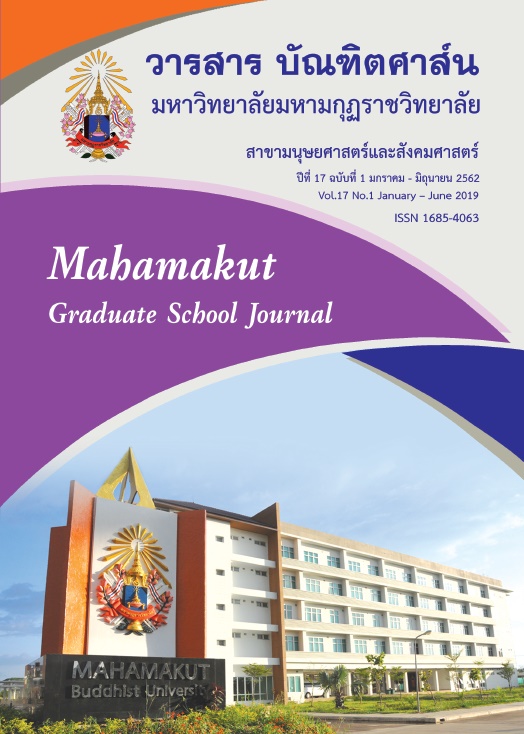Strategy for Buddhism Propagation of the National Of f ice of Buddhism in the next Decade (2016 - 2025 A.D.)
Keywords:
Strategy, Propagation of Buddhism, Next DecadeAbstract
The objectives of this dissertation were to study the operation state of Buddhist propagation and the Buddhist propagation strategy undertaken by the National Office of Buddhism in the next decade. The EDFR technic was employed in conducting the research. The data were collected from seventeen specialists through semi-structural open-ended interview form and the five-rating scale questionnaire based on the Likert scale. The qualitative data were analyzed by content analysis and content sysnthesis, and quantitative data were analyzed by computerized program, median and interquartile range.The research results were found as follows:1. The propagation of Buddhism conducted by the National Office of Buddhism did not cover the whole propagation procedure,reflected in minimal scale with the changing situation of the world and in passive procedure rather than in active one. Moreover, budget,personnel, modern technology and innovation
all were in shortage. This included the limitation of proper cooperation with other related organizations and the absence of the measures to produce competent staff. 2. The strategy for propagation of Buddhism by the National Office of Buddhism in the next decade was found to be developed as follows:Staff members should comprise bothmonks and laymen, well-trained and well-versed in Dhamma knowledge and worldly knowledge, in modern technology, languages, and public relation. The staff database, administration structure, competency evaluation measures,
and network building should be brought into practice.The Dhamma contents to be taught should be the basic principle neededfor daily life and related to economic and social development. Dhamma study policy and Dhamma principles should be pushed forward as the national Dhamma principles. Monks should be supported and facilitated in learning Dhamma, and Dhamma courses and principles should be designed for learning in a standard level, and moreover, they should be translated into various languages. Formats and methods should be designed to suit various traditional and cultural aspects, covering family life, life style and social surroundings. Propagation strategy should be systematized, proactive and focused on niche market.
As for communication, monk’s behaviors could still create interest and faith of people. Temples and modern ICT should beused as the media through which the spreading should be more effective. The cooperation of experts concerned is needed. For the support aspect, sufficient budget, high-caliber staff, strong network, accurate information together with TV and radio stations for the particular purpose are required.
References
2.คณะกรรมการวิชามนุษย์กับสังคม. (2555). มนุษย์กับสังคม. (พิมพ์ครั้งที่ 10).กรุงเทพมหานคร สำนักพิมพ์มหาวิทยาลัยเกษตรศาสตร์.
3.ธีรพงษ์ มหาวีโร. (2555). แผนพัฒนาเศรษฐกิจและสังคมแห่งชาติ ฉบับที่ 11 (พ.ศ.2555-2559). กรุงเทพมหานคร :เดอะบุคส์.
4.พระธรรมปิฎก (ป.อ.ปยุตโต). (2546). การพัฒนาที่ยั่งยืน (Sustainable Development). (พิมพ์ครั้งที่ 9).กรุงเทพมหานคร: โรงพิมพ์เรือนแก้ว.
5.พระไพศาล วิสาโล. (2552). พุทธศาสนาในอนาคต. (พิมพ์ครั้งที่ 2). กรุงเทพมหานคร:สำนักพิมพ์โกมลคีมทอง.
6.เสน่ห์ จุ้ยโตและคณะ. (2547). การจัดการทรัพยากรมนุษย์ หน่วยที่ 4. นนทบุรี : สำนักพิมพ์มหาวิทยาลัยสุโขทัยธรรมาธิราช.
7.ณัฐการ บุญรักษา. (2557). การบริหารสถานศึกษาสู่ประชาคมอาเซี่ยน สำนักงานเขตพื้นที่การศึกษามัธยมศึกษา เขต 8. วิทยานิพนธ์การบริหารการศึกษามหาบัณฑิต, คณะศึกษาศาสตร์, มหาวิทยาลัยมหามกุฏราชวิทยาลัย.
8.พระมหาธรรมรัต อริยธมฺโม (ยศขุน). (2552). แนวทางการจัดการศึกษาของคณะสงฆ์ไทยในบริบทแห่งสังคมไทยยุคปัจจุบัน. วิทยานิพนธ์ศาสนศาสตรดุษฎีบัณฑิต, บัณฑิตวิทยาลัย, มหาวิทยาลัยมหามกุฏราชวิทยาลัย.ฃ
9.พระมหามนตรี ศรีบุญฮุง. (2550). แนวทางการเผยแผ่พระพุทธศาสนาของพระธรรมทูตสายต่างประเทศในทรรศวรรษหน้า (พ.ศ.2551-2560). วิทยานิพนธ์ศึกษาศาสตรมหาบัณฑิต, บัณฑิตวิทยาลัย, มหาวิทยาลัยศิลปากร.
10.พระมหาสุริยา วรเมธี และคณะ. (2556). ศึกษาแนวคิดและหลักการในการเผยแผพระพุทธศาสนาของพระธรรมทูตไทยในสหรัฐอเมริกา. ผลงานวิจัย, มหาวิทยาลัยมหาจุฬาลงกรณราชวิทยาลัย.
11.เพชรพิกุล ณ นคร. (2555). ประสิทธิภาพการเผยแผ่พระพุทธศาสนาของพระธรรมทูต คณะธรรมยุตในประเทศสหรฐั อเมรกิา. วิทยานิพนธ์ศาสนศาสตรดุษฎีบัณฑิต, บัณฑิตวิทยาลัย, มหาวิทยาลัยมหามกุฏราชวิทยาลัย.
12.มลฑา กระวีพันธ์. (2555). การประยุกต์หลักพุทธธรรมไปใช้ในการดำเนินชีวิตที่ดีงามของนักเรียนระดับช่วงชั้นที่ 4 อำเภอร่อนพิบูล จังหวัดนครศรีธรรมราช. วิทยานิพนธ์ศาสนศาสตรดุษฎีบัณฑิต, บัณฑิตวิทยาลัย,มหาวิทยาลัยมหามกุฏราชวิทยาลัย.
13.รชต แหล่งสิน. (2555). บูรณาการการเผยแผ่พระพุทธศาสนาเถรวาทด้วยเทคนิคหลังนวยุค. วิทยานิพนธ์ศาสนศาสตรดุษฎีบัณฑิต, บัณฑิตวิทยาลัย,มหาวิทยาลัยมหามกุฏราชวิทยาลัย.
14.วงศกร เพิ่มผล. (2555). ศีล 5 : มิติอารยธรรมสากล. วิทยานิพนธ์ศาสนศาสตรดุษฎีบัณฑิต, บัณฑิตวิทยาลัย,มหาวิทยาลัยมหามกุฏราชวิทยาลัย.
15.พระพยับ ปญฺญาธโร. (๒๕๔๘.). คำวิพากษ์และข้อเสนอแนะร่างยุทธศาสตร์การเผยแผ่. สืบค้น 5 พฤษภาคม 2557,จาก http://www.newworldbelieve.net/index.
16.เบญจมาศ สุขศรีเพ็ง. (2550). ทฤษฎีแรงสนับสนุนทางสังคม (Social Support Theory). สืบค้น 7 กันยายน 2558,จาก http://www.gotoknow.org./post/115753
17.พระธรรมโกศาจารย์. (ประยูร ธมฺมจิตโต). (2556). พระพุทธศาสนาในประเทศไทยสมัยปัจจุบัน. สืบค้น 13 ธันวาคม2556, จาก http:www.dhammathai.org
18.มัลลิการ แก้วเกิด. (2558). 84000 พระธรรมขันธ์. สืบค้น 23 มิถุนายน 2561, จาก http://www.gotoknow.org.
19.ภิญโญ ทองดี. (มปป.). ครอบครัวและสถาบันครอบครัว. สืบค้น 23 มิถุนายน 2561, จากhttp://www.human.cmu.ac.th.
20.มยุรดา สุวรรณโพธิ์. (2557). จิตวิทยามวลชน. สืบค้น 23 กุมภาพันธ์ 2560, จาก http://www.Thaifamilylink.net/web./node/75
21.สมชาย วรกิจเกษมสกุล. (2554). ระเบียบวิธีวิจัยทางพฤติกรรมศาสตร์และสังคมศาสตร์ คณะครุศาสตร์ มหาวิทยาลัยราชภัฏอุดรธานี. สืบค้น 9 ธันวาคม 2561, จาก www.udru.ac.th
22.อัจฉริยาภร กิ่งการ. (มปป.). องค์ประกอบแบบ 6 M . สืบค้น 9 ธันวาคม 2561, จาก autchariyaporn.blogsport.comJohn W. Best. (1970). Research in Education. Englewood Clift. New Jersey : Perntice Hall In
Downloads
Published
How to Cite
Issue
Section
License
บทความวิชาการและบทความวิจัยในวารสารฉบับนี้ถือเป็นความรับผิดชอบของผู้เขียนเท่านั้น บทความที่ได้รับการตีพิมพ์ในวารสารบัณฑิตศาส์น ถือเป็นลิขสิทธิ์ของมหาวิทยาลัยมหามกุฏราชวิทยาลัย ตามพระราชบัญญัติลิขสิทธิ์


